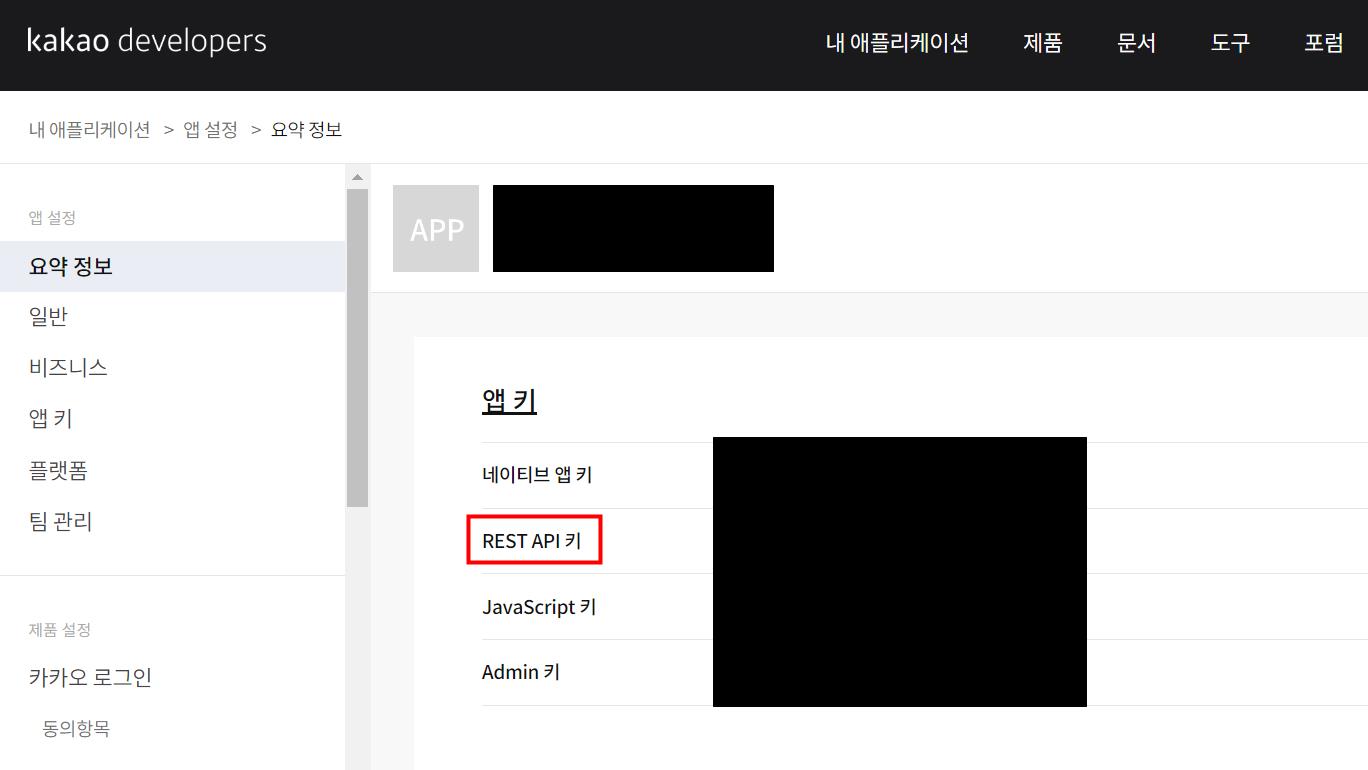SpringBoot 프로젝트에서 OAuth2와 spring security를 사용하여 카카오API를 이용한 소셜 로그인을 구현하고 DB에 넣는것까지 완성했다.
개발 환경
- Spring Boot 2.7.15
- Java 11
- spring security 5
- Maria DB
카카오 로그인 API는 이런식으로 진행된다.

1. Kakao Developers 에서 애플리케이션 등록
Kakao Developers에서 애플리케이션을 추가한다.
앱 이름과 사업자명은 편하게 설정
애플리케이션이 추가되면 여러 종류의 키가 생성되는데 이 중에서 REST API 키는 application.properties에서 spring.security.oauth2.client.registration.kakao.client-id= 에 작성한다.
Web 플랫폼을 지정하고 사이트 도메인은 http://localhost:8080 으로 지정 (나중에 호스팅을 이용할 때는 변경)
동의 항목을 지정하는데 '닉네임'과 '카카오 계정'을 선택했다.
카카오 로그인 활성화 ON
아래로 스크롤하면 'Redirect URI'를 지정하는 부분이 나온다. 여기에서 값은 http://localhost:8080/login/oauth2/code/kakao 로 지정했다.
보안 항목에서 'Client Secret'으로 코드를 생성받는다.
이 코드는 application.properties에서 spring.security.oauth2.client.registration.kakao.client-secret= 에 작성한다.
2. build.gradle에 스프링 시큐리티, DB 관련된 dependencies 추가
implementation 'org.springframework.boot:spring-boot-starter-thymeleaf'
implementation 'org.springframework.boot:spring-boot-starter-web'
compileOnly 'org.projectlombok:lombok'
developmentOnly 'org.springframework.boot:spring-boot-devtools'
annotationProcessor 'org.projectlombok:lombok'
testImplementation 'org.springframework.boot:spring-boot-starter-test'
implementation 'org.springframework.boot:spring-boot-starter-data-jpa'
implementation 'org.springframework.boot:spring-boot-starter-security'
implementation 'org.springframework.security:spring-security-oauth2-client'
implementation 'org.thymeleaf.extras:thymeleaf-extras-springsecurity5'
testImplementation 'org.springframework.security:spring-security-test'
runtimeOnly 'org.mariadb.jdbc:mariadb-java-client'3. application.properties에 Kakao와 DB 관련 설정 추가
# Kakao
spring.security.oauth2.client.provider.kakao.authorization-uri=https://kauth.kakao.com/oauth/authorize
spring.security.oauth2.client.provider.kakao.user-name-attribute=id
spring.security.oauth2.client.provider.kakao.token-uri=https://kauth.kakao.com/oauth/token
spring.security.oauth2.client.provider.kakao.user-info-uri=https://kapi.kakao.com/v2/user/me
spring.security.oauth2.client.registration.kakao.client-name=kakao
spring.security.oauth2.client.registration.kakao.authorization-grant-type=authorization_code
spring.security.oauth2.client.registration.kakao.redirect_uri=http://localhost:8080/login/oauth2/code/kakao
spring.security.oauth2.client.registration.kakao.client-id=
spring.security.oauth2.client.registration.kakao.client-secret=
spring.security.oauth2.client.registration.kakao.client-authentication-method=POST
spring.security.oauth2.client.registration.kakao.scope=profile_nickname,account_email
# MariaDB
spring.datasource.driver-class-name=org.mariadb.jdbc.Driver
spring.datasource.url=jdbc:mariadb://localhost:(포트번호)/(Database명)
spring.datasource.username=(계정명)
spring.datasource.password=(비밀번호)client-id= 는 REST API 키
client-secret= 은 Client Secret 코드
DB 관련 설정은 본인의 DB에 맞게 수정한다.
4. 테스트할 로그인 페이지 만들기
- 메인 페이지
<!DOCTYPE html>
<html lang="en">
<head>
<meta charset="UTF-8">
</head>
<body>
<a sec:authorize="isAnonymous()" th:href="@{/user/login}">로그인</a>
<a sec:authorize="isAuthenticated()" th:href="@{/user/logout}">로그아웃</a>
</body>
</html>- 로그인 페이지
<!DOCTYPE html>
<html lang="en">
<head>
<meta charset="UTF-8">
</head>
<body>
<div>
<input type="button" onclick="location.href='/oauth2/authorization/kakao'">
</div>
</body>
</html>5. Controller
@Controller
@RequestMapping("/user")
public class UserController {
@GetMapping("/login")
public String login() {
return "login";
}
@GetMapping("/logout")
public String logout(HttpServletRequest request, HttpServletResponse response) {
Authentication authentication = SecurityContextHolder.getContext().getAuthentication(); // 현재 인증 객체(Authentication)를 가져옴
if (authentication != null) { // 가져온 인증 객체를 이용하여 SecurityContextLogoutHandler를 통해 로그아웃 실행
new SecurityContextLogoutHandler().logout(request, response, authentication);
}
return "redirect:/";
}6. SecurityConfig
@Configuration // 해당 클래스를 스프링 설정 클래스로 등록
@EnableWebSecurity // spring security 설정을 활성화
public class SecurityConfig extends WebSecurityConfigurerAdapter {
@Autowired // 해당 타입의 빈을 자동으로 주입
private CustomOAuth2UserService customOAuth2UserService;
@Override // 상위 클래스의 메소드를 오버라이드
protected void configure(HttpSecurity http) throws Exception {
http
// 카카오 로그인
.authorizeRequests() // HttpServletRequest에 따라 접근을 제한하거나 허용하려면 사용
.antMatchers("/", "/user/**", "/search_fail", "/게시판").permitAll() // 해당 경로에 대한 모든 요청을 허용
.antMatchers( "/static1/**", "/static2/**").permitAll() // 정적 자원에 대한 접근 허용
.anyRequest().authenticated() // 그 외의 모든 요청은 인증이 필요
.and()
.oauth2Login() // OAuth 2 로그인 기능 활성화
.userInfoEndpoint() // OAuth2 로그인 성공 이후 사용자 정보를 가져올 때 설정을 저장
.userService(customOAuth2UserService) // OAuth 2 사용자 정보를 얻기 위한 서비스 지정
.and()
.defaultSuccessUrl("/") // 로그인 성공 시 리다이렉트할 URL
.failureUrl("/login?error=true") // 로그인 실패 시 리다이렉트할 URL
.and()
.csrf().ignoringAntMatchers("/", "/user/**", "/search_fail", "/게시판") // CSRF 보호에서 제외 페이지
.and()
.headers().frameOptions().disable() // X-Frame-Options 헤더를 비활성화하여 iframe 내에서 페이지를 렌더링 허용
.and()
// 카카오 로그아웃
.logout()
.logoutUrl("/user/logout") // 로그아웃을 수행하는 URL
.logoutSuccessUrl("/") // 로그아웃 성공 후 리다이렉트할 URL
.invalidateHttpSession(true) // 세션 무효화
.addLogoutHandler((request, response, authentication) -> { // 소셜 로그아웃 처리 및 세션 관련 작업 등 추가
HttpSession session = request.getSession(); // 세션을 무효화하여 사용자의 세션 정보를 제거
session.invalidate();
})
.logoutSuccessHandler((request, response, authentication) -> response.sendRedirect("/user/login")) // 소셜 로그아웃 성공 후 처리 및 리다이렉트3
.deleteCookies("remember-me"); // 로그아웃 시 제거할 쿠키를 설정
}
}7. User 도메인
@Entity // JPA를 사용하여 테이블과 매핑할 클래스임을 나타냅니다.
@Getter // Lombok을 사용하여 getter 메소드를 자동으로 생성합니다.
@Setter // Lombok을 사용하여 setter 메소드를 자동으로 생성합니다.
@RequiredArgsConstructor // Lombok을 사용하여 final이나 @NonNull 필드만 매개변수로 갖는 생성자를 생성합니다.
public class User {
@Id // 해당 프로퍼티가 테이블의 기본 키 역할을 한다는 것을 나타냅니다.
@GeneratedValue(strategy = GenerationType.IDENTITY) // 기본 키 생성 전략을 지정합니다. IDENTITY는 데이터베이스에 위임하는 방식입니다.
private Long user_id;
private String email; // 사용자의 이메일 주소를 저장하는 프로퍼티
private String nickname; // 사용자의 별명을 저장하는 프로퍼티
// email과 nickname을 매개변수로 받는 생성자입니다.
// Lombok의 @RequiredArgsConstructor 어노테이션으로 인해 필요없게 될 수도 있습니다.
public User(String email, String nickname) {
this.email = email;
this.nickname = nickname;
}
}8. UserRepository
public interface UserRepository extends JpaRepository<User, Long> {
Optional<User> findByEmail(String email); // email을 이용해서 회원 정보 찾음
}9. CustomOAuth2UserService
@Service // 해당 클래스를 Spring의 Service로 등록합니다. 비즈니스 로직을 포함하는 클래스에 주로 사용됩니다.
@RequiredArgsConstructor
public class CustomOAuth2UserService extends DefaultOAuth2UserService {
@Autowired // Spring의 DI를 사용하여 userRepository 인스턴스를 자동으로 주입받습니다.
private UserRepository userRepository;
private final HttpSession httpSession;
@Override // 부모 클래스의 메소드를 오버라이드 합니다.
public OAuth2User loadUser(OAuth2UserRequest userRequest) throws OAuth2AuthenticationException {
OAuth2User oauth2User = super.loadUser(userRequest); // 부모 클래스의 loadUser 메소드를 호출하여 기본 OAuth2User를 가져옵니다.
// 사용자의 OAuth2 인증 정보에서 가져온 속성들을 저장하는 Map 객체를 생성합니다.
Map<String, Object> attributes = new HashMap<>(oauth2User.getAttributes());
System.out.println(attributes); // 가져온 속성들을 로그로 출력합니다.
// 카카오 API로부터 반환된 "kakao_account" 속성을 맵으로 추출합니다.
Map<String, Object> kakaoAccount = (Map<String, Object>) attributes.get("kakao_account");
String email = (String) kakaoAccount.get("email"); // "kakao_account"에서 "email" 속성을 가져옵니다.
// "kakao_account"의 "profile" 속성을 맵으로 추출합니다.
Map<String, Object> profile1 = (Map<String, Object>) kakaoAccount.get("profile");
String nickname = (String) profile1.get("nickname"); // "profile"에서 "nickname" 속성을 가져옵니다.
// "kakao_account"의 "profile" 속성을 맵으로 추출합니다.
Map<String, Object> profile2 = (Map<String, Object>) kakaoAccount.get("profile");
// attributes 맵에 email과 nickname 속성을 추가합니다.
attributes.put("email", email);
attributes.put("nickname", nickname);
// 데이터베이스에서 해당 이메일을 가진 사용자를 찾습니다.
// 없을 경우 새로운 User 객체를 생성하고 저장한 뒤 반환합니다.
User user = userRepository.findByEmail(email)
.orElseGet(() -> {
User newUser = new User(email, nickname, pw);
return userRepository.save(newUser);
});
// OAuth2 인증에 사용될 사용자 정보를 담고 있는 DefaultOAuth2User 객체를 생성하여 반환합니다.
return new DefaultOAuth2User(
Collections.singleton(new SimpleGrantedAuthority("ROLE_USER")), // 기본 권한을 설정합니다.
attributes, // OAuth2 인증 정보의 속성들
"email"); // 이름 필드의 키를 "email"로 설정합니다.
}진행 사항
카카오 로그인을 완료하면 데이터베이스 USER 테이블에 동일한 email이 없을 경우, 사용자 email과 nickname이 저장된다.
문제점
로그아웃 후 로그인 페이지까지는 원하는 대로 진입하는데, 로그아웃을 했음에도 불구하고 카카오 로그인을 시도하면 자동 로그인 된 것처럼 바로 로그인이 되어버린다.
카카오 로그인했을 때 토큰 정보를 받아서 저장해놨다가 로그아웃할 때 버려야 한다는데 거기까진 아직 구현이 안 됐다.







